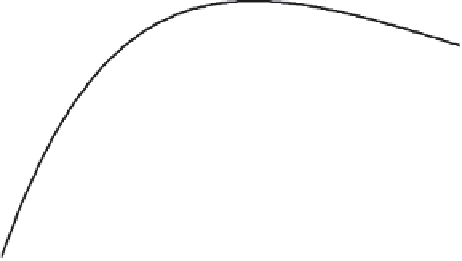Environmental Engineering Reference
In-Depth Information
3
2
P
max
1
Compensation point
A
0
Respiration
-1
0
400
800
1200
1600
2000
3
High light adapted
2
Low light adapted
1
0
B
-1
0
400
800
1200
1600
2000
mol quanta m
-2
s
-1
)
Light (
μ
FIGURE 11.9
Diagram of a representative relationship between net photosynthetic rate and
irradiance (A) and comparison of high-light- and low-light-adapted species (B). The low-light
species has a steeper
, lower compensation point and
P
max
, and greater photoinhibition. Ir-
radiance is in photosynthetically available radiation, and photosynthetic rate is in arbitrary
units. A single species can acclimate to light in a similar fashion.
Mixing also influences the light regime of phytoplankton in lakes. If
turbulent mixing is deep enough the average light experienced can be too
low to support growth. The mixing depth below which growth does not
occur is called the
critical mixing depth
. Phytoplankton are most likely to
be mixed below the critical depth during winter, when a lake is not strat-
ified and ambient light is low.
Likewise, organisms that live in intense sunlight near the water's sur-
face have special characteristics that allow them to succeed in this harsh
habitat. The strongest effect of high light is photoinhibition caused by the
direct or indirect damaging effects of high-intensity light on the molecules
in the cells. The most likely site of damage in photoinhibited cells is in the
photosynthetic apparatus at photosystem II (Long
et al.,
1994). Most stud-
ies of photoinhibition in the natural environment have been on terrestrial
plants and phytoplankton (Long
et al.,
1994). Photosynthetic organisms
can protect themselves from high light by synthesizing special protective
pigments and, if they are motile, by moving into areas with lower irradi-
ance. Organisms that are acclimated to intense light have low values for









































Search WWH ::

Custom Search